Fair Start Scotland - evaluation report 3: year two - overview
Third report in a series of evaluation reports of Fair Start Scotland employability services which covers the second full year of service delivery (April 2019 - March 2020) and summarises findings from a participant phone survey, local area case studies and analysis of management information.
7. Moving towards work
This chapter focuses on the number of people moving into work, and looks at this by different demographic groups.
It begins by looking at the MI data for job starts and 3 and 6 month outcomes. It then uses data from the telephone survey of FSS participants to explore the type of work that people are moving into. Finally it looks at the Job Search Self Efficacy scores of survey participants to explore the impact of FSS on job search skills.
7.1 Who started (and sustained) work? – MI data
Not enough time has passed to present a complete picture of employment outcomes for people joining in the second year of FSS. This is because many of the people who joined in the second year are still completing 12 to 18 months of pre-employment support, and then we need to account for the time it takes to reach a 3, 6 and 12 month outcome.
Therefore this section reports on the picture being developed in the second year of FSS in relation to who started (and sustained) work – so, most of the people included in this analysis will have started in the first year of FSS. Even now, not enough time has passed for us to get a complete picture of 12 month outcomes for the first year – so this breakdown has not been included.
One in three people joining FSS started a job (33%). Once starting work, most people (nearly 3 in 4 people: 72%) went on to sustain employment for at least 3 months, and 77% of the people who sustained employment for 3 months went on to reach 6 months employment.
The figures below shows the variation in proportions of people with different demographics starting a job and staying in work for at least 3 to 6 months.
Compared to all FSS participants, a lower proportion of disabled people and older people went on to start work after joining FSS. There was little difference by gender. A lower proportion of people with convictions, people who were unemployed for more than 2 years, and people who were both unemployed for more than 2 years and disabled went on to start work after joining FSS.
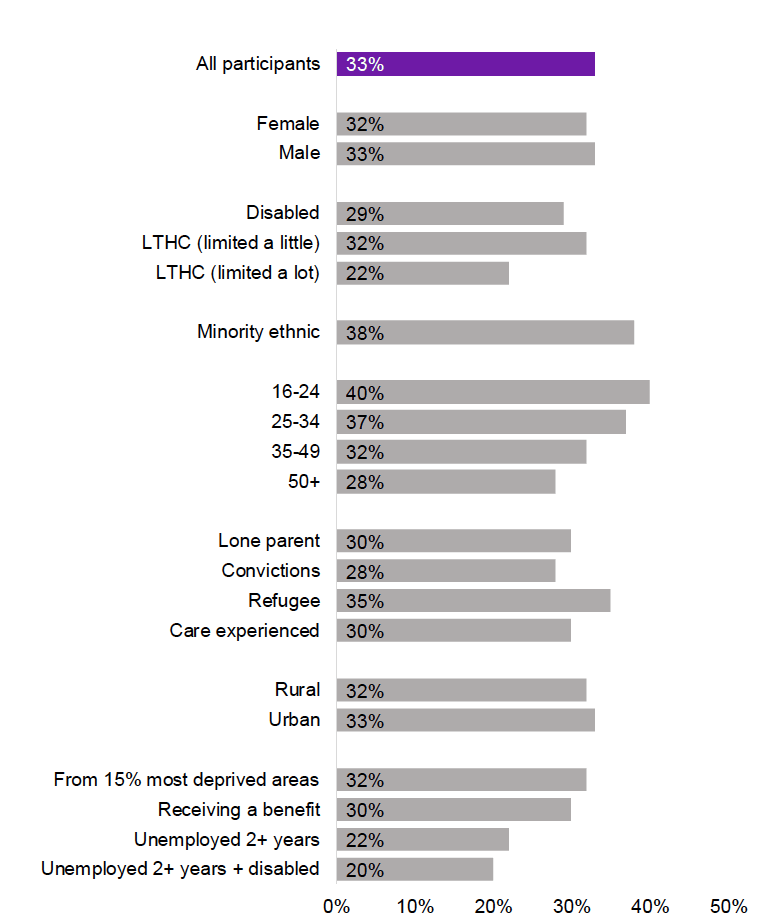
Compared to all participants, a lower proportion of disabled people, those limited 'a lot' by a LTHC, and older people sustained work for 3 months. A higher proportion of young people and minority ethnic people sustained employment for 3 months. Similar to job starts, compared to all participants, a lower proportion of people with convictions, people who were care experienced, people who were unemployed for more than 2 years, and people who were both unemployed for more than 2 years and disabled sustained employment for 3 months.
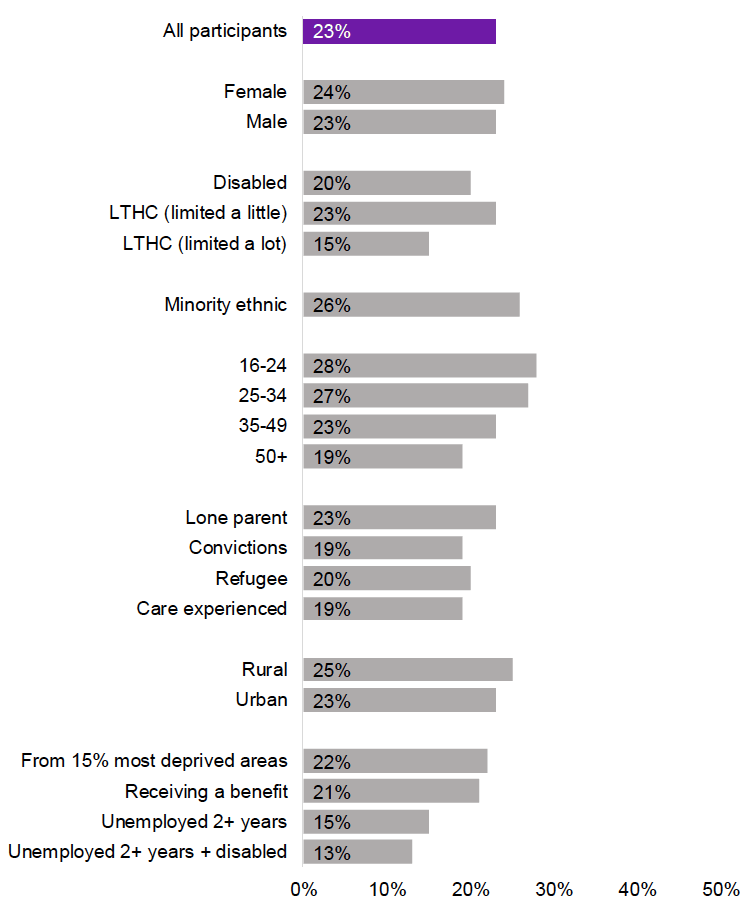
Similar to job starts and 3 month outcomes, a lower proportion of disabled people, those limited 'a lot' by a LTHC, and older participants sustained employment for 6 months. A higher proportion of younger and minority ethnic participants sustained employment for 6 months. A lower proportion of people who were care experienced, who were unemployed for more than 2 years, and people who were both unemployed for more than 2 years and disabled sustained employment for 6 months.
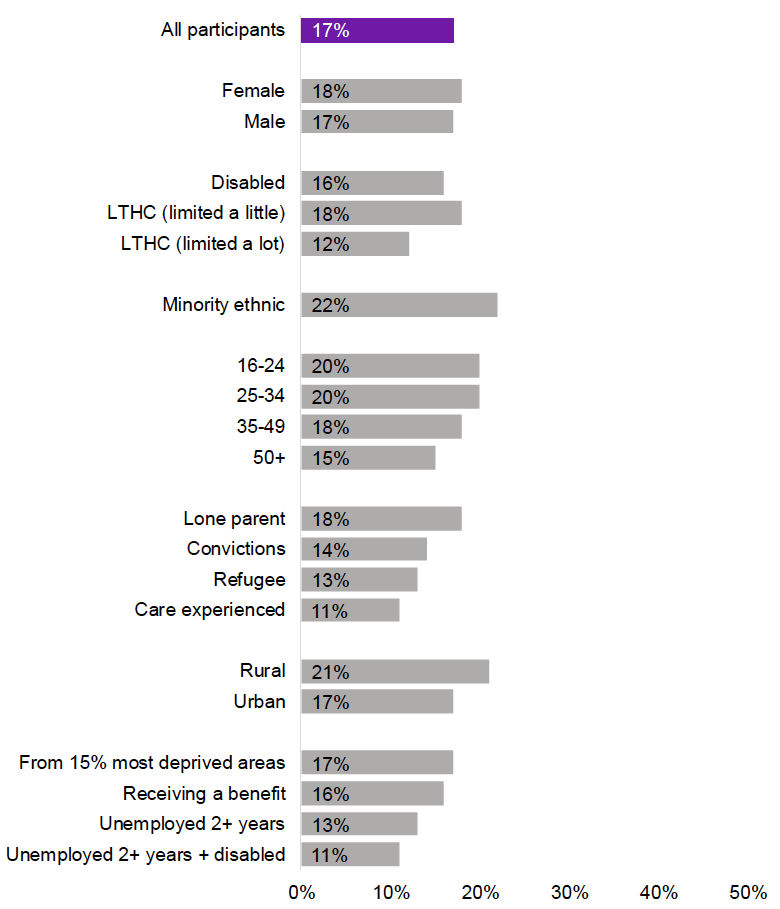
7.2 Who started (and sustained) work? – telephone survey data
Telephone survey respondents were asked about their work status.
At the time of the survey, 35% of year 1 participants and 31% of year 2 participants reported that they were either working for an employer in a paid role or were self-employed[11].
MI data shows that 32% of participants who started in year 1 had moved into work by June 2020. The data for year 2 (which, as mentioned above, is incomplete due to not enough time passing) indicates 28% of year 2 participants had started work by this date.
Figure 13 below shows the profile of working participants by occupation. They are ordered based on the ONS hierarchy which moves from highly skilled professions at the top, to less skilled professions at the bottom.
The most common grouping was elementary occupations (e.g. cleaners, security guards, waiting staff), representing four in ten (41%) participants who had worked in the last week. Following that, 16% worked in sales and customer service occupations. Around one in ten worked in caring leisure and other service occupations (12%), process plant and machine operatives (e.g. drivers, machine operatives) (9%) and administrative and secretarial occupations (9%).
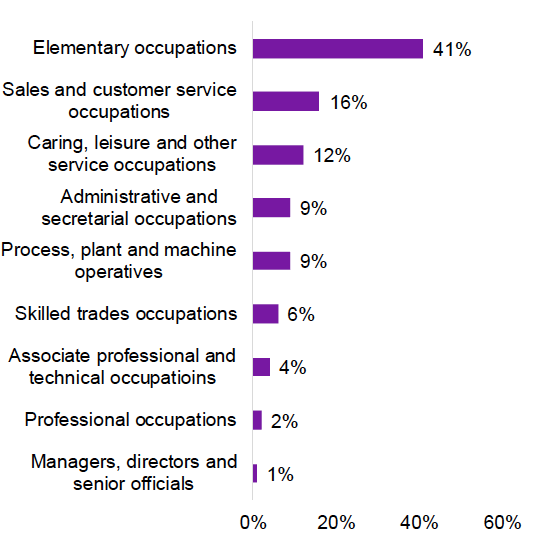
Source: IFF Research telephone survey of FSS customers. Taken from collating and coding answers from A5: What is/was your job title? And A6: What do/did you mainly do in your job? Base: 2019 cohort that were employed, self-employed or had worked in the last week (341).
One case study participant with a degree felt that FSS was geared more towards people seeking jobs in call centres, care or basic administrative positions rather than "roles for those who are better qualified". Another university graduate, with over 45 years' experience, applied for jobs without his key worker's support and reported that FSS was "not terribly useful" in finding suitable opportunities. Key workers also cited a few highly qualified and/or experienced participants who "did not need a lot of help".
Telephone survey participants that had worked in the last week were asked about their income from this employment. Three in ten earned the national minimum wage or below (30%)[12]. Around six in ten (61%) earned above the national living wage, the majority of whom earned £8.22 to £9.30 an hour (36%) or £9.30-£15.00 (22%). A small minority earned above £15.01 an hour (3%).
These participants were also asked about the type of employment contract they held. Over half were employed on a permanent contract (56%). Around one quarter were employed on a temporary employment contract (23%) with a further 10% employed on zero hours contracts. One in twenty were self-employed (6%), though individuals in priority families were more likely to be self-employed than those not part of the priority family groups (15%, compared to 4%).
Providers in the case study areas felt that relationships with employers were key. They felt that spending time with employers was valuable, as once a participant is placed, it allows key workers to provide appropriate in-work support and act as a go between which contributes to a sustainable outcome. For example, the key worker will talk to the employer on behalf of the participant to address support needs, and the employer can approach the key worker if they have concerns about the participant. This open, two-way relationship was felt to be important for ensuring sustainable outcomes.
"We spend time making sure it is the right opportunity for the participant. We need to work at their pace, listen to them. It's not just trying to get them into a job – it's spending time up front to get the right opportunity."
- Fair Start Scotland Provider, Drumchapel
7.3 Job search skills and self-efficacy
FSS is rooted in the principles of dignity and respect, and the service model is designed to treat individuals in a way that reflects these values. This will manifest in a number of ways, one of which may be by nurturing a sense of self-efficacy in those who participate.
Self-efficacy refers to an individual's belief in their own ability to organise and carry out actions in order to successfully achieve a task. It is based on a person's perceptions and beliefs about themselves. The level of self-efficacy experienced by a person can have an impact on many areas of life, particularly those that are relevant to finding and maintaining employment.
In order to explore the effects of FSS support on participants' self-efficacy, and to establish any links to being treated with dignity and respect, the participant phone survey included a section on standardised job search self-efficacy measures. Respondents completed a nine-item measure of the strength of an individual's belief that they have the skills to undertake a range of job search tasks, known as the Job Search Self Efficacy (JSSE) Index.
Across the year 2 telephone survey participants, there were differences between the level of confidence reported in job search activities between those who reported that they were in work at the time of the interview and those who reported they were not.
As can be seen in Figure 14 below, those who reported they were in employment were more likely to feel more confident across all measures. The biggest differences between those who reported they were vs those who reported they were not in employment were in 'talking to friends/other contacts to find potential employers who need your skills' and 'talking to friends/other contacts to discover promising job openings suitable for you'. This could suggest that informal networks of contacts may be important for finding work for FSS participants. There were also larger differences between 'making the best impression and getting your points across in a job interview' and 'contacting and persuading potential employers to consider you for a job' which suggest that communications and confidence skills are also key to finding employment.
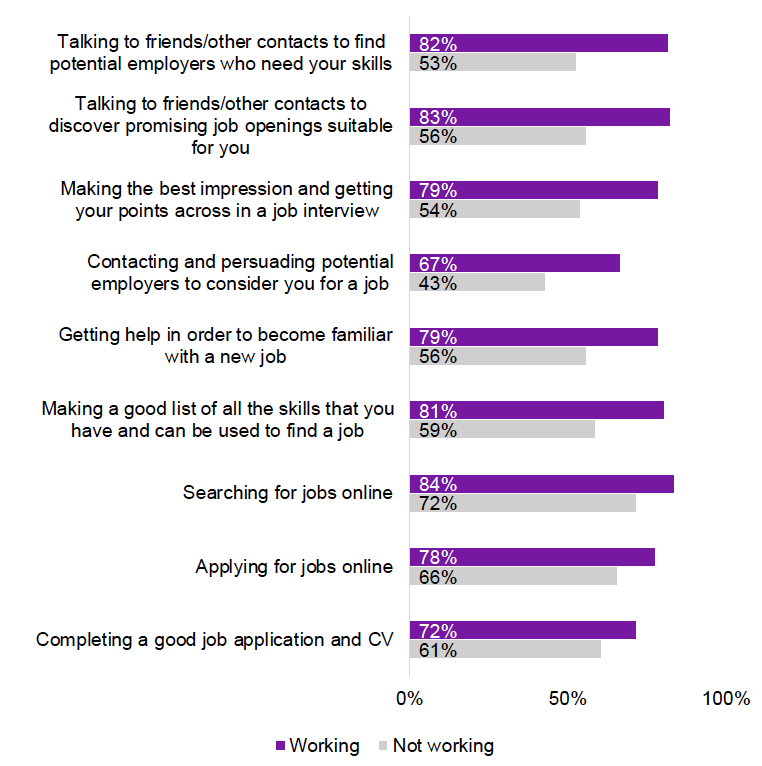
Source: How confident do you feel about doing the following things successfully? Base: All 2019 Cohort (607)
There were some differences in terms of participant confidence about individual job search skills:
- Those limited by a long-term health condition were less likely to feel confident talking to friends and other contacts to find out about potential employers (53%) and completing a CV or job application (56%)
- Those with a degree were more likely to feel confident making a list of their skills to find a job than those with lower level or no qualifications (degree; 79%, none; 63%, National 1-5; 67%). They were also more likely to feel confident about completing a CV or job application (82% compared to the average of 64%)
- Men were more likely than women to feel confident talking to friends and other contacts to discover promising job openings (70% compared to 61%)
Many participants interviewed in the case study areas reported that they had found work as a result of the support they had received. Participants reported starting jobs in a range of sectors including call centres, retail, manufacturing and administration, and they felt that FSS had been crucial in helping them to build the confidence, skills and experience to successfully enter employment.
Within the case study areas there were a few participants who were very far removed from the labour market due to severe health problems or childcare issues, and entering employment did not appear to be a realistic goal for them in the short- to medium-term. This was emphasised by the follow-up interviews conducted with year 1 participants, which confirmed that at least two participants, while satisfied with the support they had received from FSS, had not moved into employment in the year since researchers last spoke to them. These two participants acknowledged that employment is a very difficult objective to achieve just now given their personal circumstances, and they were not surprised that they had not found work.
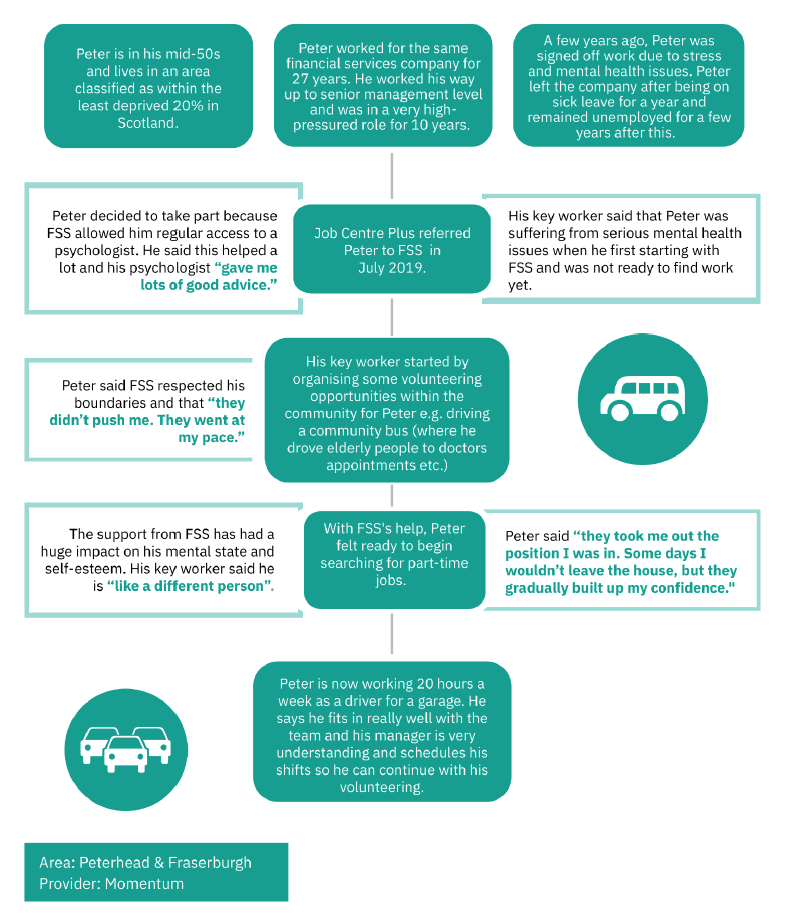
What worked well?
Younger people, women, and those from ethnic minority backgrounds are all doing well in terms of finding and sustaining work. This is interesting to note given that the same groups are under-represented on the service when compared to the overall unemployed population as previously noted.
At the time of the telephone survey, almost a third of year 2 participants reported they were in work.
What could be improved?
There are some groups for whom starting and sustaining work seems to be more difficult, such as those who are disabled, those with convictions and those who are care experienced.
There is also some evidence from the data where enough time has passed in pre-employment support and for outcomes that FSS participants with significant barriers to the labour market are less likely to be in work.
What are we doing?
FSS remains focused on providing support for unemployed people with disabilities and health conditions, as well as other barriers.
Scottish Government continues to monitor the quality of service delivered by providers to all participants through quality and compliance activity, which have now moved to service delivery reviews during the current pandemic. These allow us to understand the activity being carried out with participants and how they are progressing. These ensure that providers provide the level of service we expect to be produced and quickly identify areas requiring improvement.
During 2019 we performed an internal review of Supported Employment (SE) delivery across all the providers, as SE is an integral part of FSS delivery. The findings were shared with providers, with action plans agreed and put in place to target areas of delivery requiring improvement. We continue to monitor these as part of our contract management function.
An external review of Individual Placement and Support (IPS) delivery is currently underway with an external review of Supported Employment also in the pipeline. The findings from both these reviews will give a clear view of the level of service participants are receiving now and be used to enhance and improve the delivery of FSS to participants moving forward.
Contact
Email: socialresearch@gov.scot
There is a problem
Thanks for your feedback